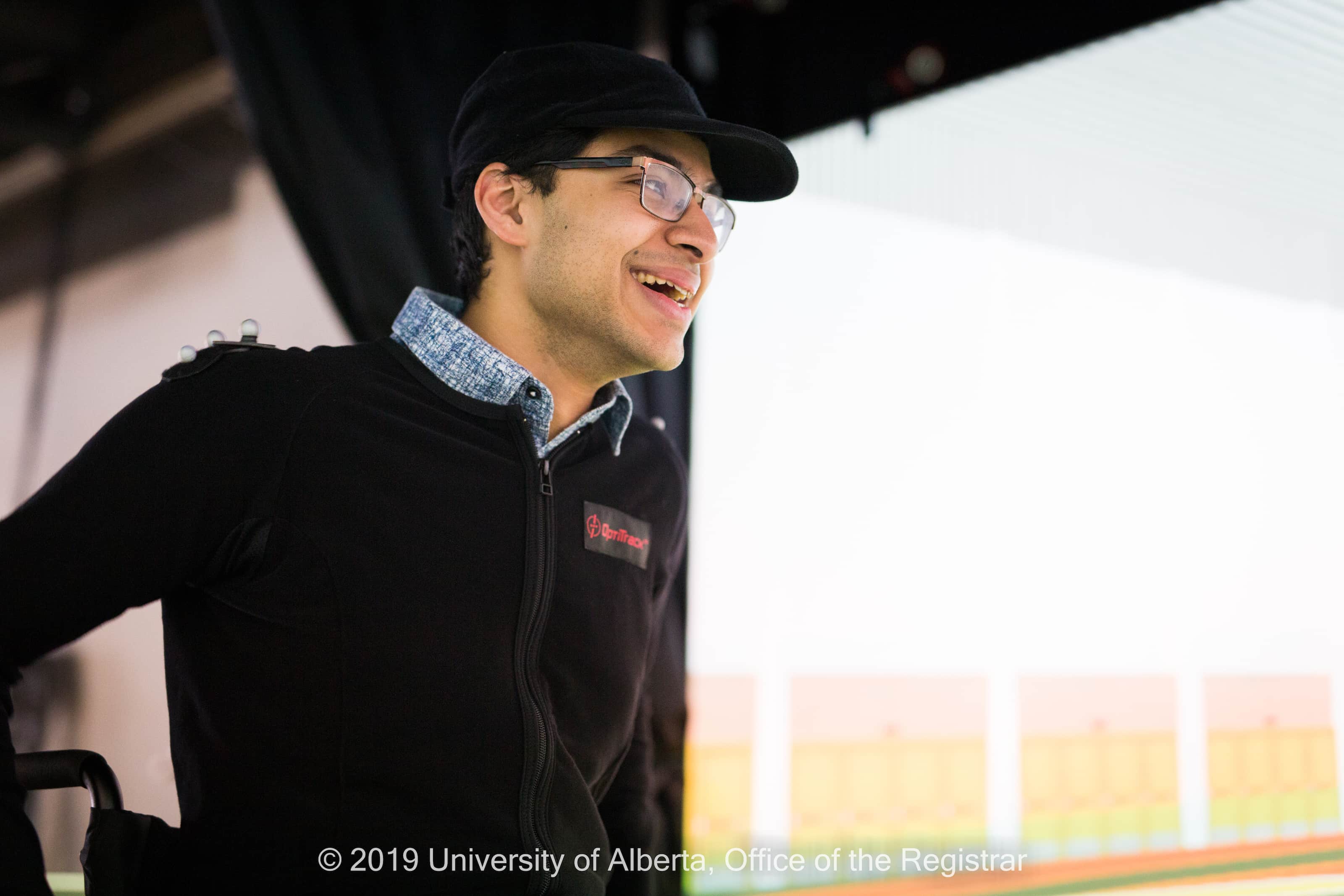How would you describe your work to people who don’t work in your field?
Wheelchair biomechanics involves understanding the most efficient ways in which wheelchair users can propel themselves. This is important to study because our built environments are not designed for wheelchair users and people with disabilities. Imagine a wheelchair user entering a coffee shop, negotiating customer traffic, maneuvering around furniture, and interacting with the barista at different eye levels to order, purchase, and carry their morning cappuccino to work, all within a limited time frame. Knowing cadence, propulsion style, and propulsion moments can help us not only enhance a wheelchair user’s experience, but also prevent secondary injury and accidents.
What does innovation mean to you?
Innovating involves repurposing as opposed to reinventing. For example, U of A's Rehabilitation Robotics Lab created a tool that was initially used for research purposes to measure the angular acceleration, velocity, and force of propulsion in manual wheelchair users. Before our device, the gold standard for extracting wheelchair-pushing data was an expensive, weighty piece of technology called SmartWHEEL which requires someone to physically attach a wheel onto a manual wheelchair.Outside of a clinical setting, it was practically useless. However, our device is a much sleeker technology that did not impede maneuverability, was lightweight, and significantly cheaper, meaning we could use the device in ways— both in the lab and in the clinic— that no one had dared to utilize.
What’s one big problem you want to solve through your work?
Working with our lab spin-off Click & Push Accessibility, I was able to partake in the process of commercializing a wheelchair fitness wearable device. I think one big problem that our product sought to address was accessibility challenges to public infrastructure for wheelchair users. I hope to find other ways to translate my work with wheelchair biomechanics into the realm of accessibility to help people with disabilities operate on the same level as those without. I also want to enhance people’s autonomy by helping them take control of their health data and making good decisions.
What is one of your core principles as an innovator?
My core principle as an innovator is to be resilient. A significant challenge of running a social enterprise is limited funding, support, and information. In the high-paced environment of startup culture, I had to improvise, overcome, and adapt to ambiguity. One skill I refined through my time with Click&Push Accessibility was the art of tailoring pitches for diverse audiences. As a team, we persistently pitched our ideas in several forms and formats. It was a highly experimental process. When met with rejection from investors, it was important not only to be resilient, but also dynamic to accommodate the needs of new prospects.

What advice would you give to someone who wants to venture into innovation but isn't sure where to begin?
Think critically about whether you have the time, bandwidth, and energy to commit. It’s important to ask the right questions, have the right team, and be at the right place at the right time. If you have clarity about your innovation, you will have much more confidence in taking the first steps towards innovation. It is important to get your hands dirty and not shy away from doing menial tasks. Everything you do has some sort of value. Whether you are scraping Petri dishes or hammering a nail, the steps you take will build your character, teamwork, and humility. These small accomplishments pave the way for bigger successes down the road.
How do you balance your work with your other studies, personal life and self care?
Short answer: I don’t. Balance is tough and drawing boundaries can be especially tough. I am still navigating the jungle of work-life balance and do not have any silver bullets. Theoretically, having plan Bs and Cs should ensure that things happen the way you want it to, but unfortunately this is almost never the case in practice. There are always setbacks and troubleshooting in both studies and personal life that may start impinging the balance. This is why I believe it is important to have a solid social support network of family, friends, and colleagues who have your back when the going gets tough.
What inspires you to continue innovating?
I enjoy the gratification that comes from hard work and putting forth something that enables and empowers others.
Shout out your work! What do you have coming up in your future?
I co-founded Click & Push Accessibility alongside my labmates at the U of A Rehabilitation Robotics Lab and validated our “wheelchair Fitbit'' wearable tech device called Sagitta. Currently, I am completing my thesis on wheelchair biomechanics under the supervision of Dr. Martin Ferguson-Pell.
On the side, I co-launched and co-designed a medical device to enhance healthcare interactions for children with cerebral palsy. I evaluated a prosthesis system for stroke patients, proposed a design for space suits during medical emergencies, and suggested an innovative strategy using compression bandages to prevent orthostatic hypotension.
This interview was edited for length and clarity.
Innovator Spotlight is a series that introduces you to students whose big ideas are making a big difference.
Do you know someone who’s breaking boundaries at the U of A? (Maybe it’s you!) We’re interested in hearing from students who are creating new solutions to make our world better, no matter their discipline or year of study.
Get in touch at youblog@ualberta.ca.

About John (He/Him)
John Christy Johnson is a second-year medical student and third-year MSc biomedical engineering student at the University of Alberta cranking the gears on a wheelchair biomechanics project at the U of A's Rehabilitation Robotics Lab. Whenever he needs to recharge his batteries, John switches it up with long bike rides by Edmonton's River Valley, doing SuDoku puzzles, or racing with his identical twin brother.
